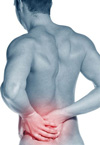What We Treat
Low Back & Leg Pain

Some 90% of adults will experience low back pain at some time of their life, most commonly between the ages of 25 – 55. The real issue though is that 70% of sufferers will have a recurring problem.
Pain can vary from a dull ache in the low back to very acute pain with symptoms all the way down the leg (or on occasion legs).
Often the pain seems to come on quite suddenly and for no apparent reason, or triggered by something very minor like stooping forwards to clean your teeth. In this case it will usually be something that has gradually been building up over a period of time, known as accumulative stress, often unnoticed , until the body reaches its limitations and a more acute situation arises.
The accumulative stress is usually as a result of poor, sustained postures during day to day activities such as sitting at a desk or in a car, or standing stooped over. Problems can arise in the discs, spinal joints and soft tissue structures of the spine (and is usually a combination of all 3)
Frequent lifting or carrying of objects, even if relatively light, will add further stress and strain to the spine as well, especially if a poor posture is adopted.

Symptoms of pain, weakness and numbness/tingling into the leg are common too. These are frequently referred to as ‘Sciatica’, but true sciatic pain is felt only in the back of the leg.
Leg symptoms can be generated from other things, not just pressure on the sciatic nerve, for example pain in the groin or front of the thigh can be due to pressure on the Femoral nerve, and also pain can be referred into specific areas such as the hip, knee or heel.
Problems with the Sacro-iliac joints in the pelvis or hip joints can also give leg symptoms.
Physiotherapy treatment for this type of problem is really 3 fold. Firstly, to reduce the acute pain, and regain mobility. This can be done in a variety of ways using spinal mobilisation and manipulation, soft tissue massage, electrotherapy and exercise.
Secondly, postural advice to try and reduce the amount of accumulative stress on the spine and thirdly a simple programme of maintenance exercises to keep the spine flexible and the core muscles (the abdominals and those working directly on the spine) working well to support the spine in a neutral position.


